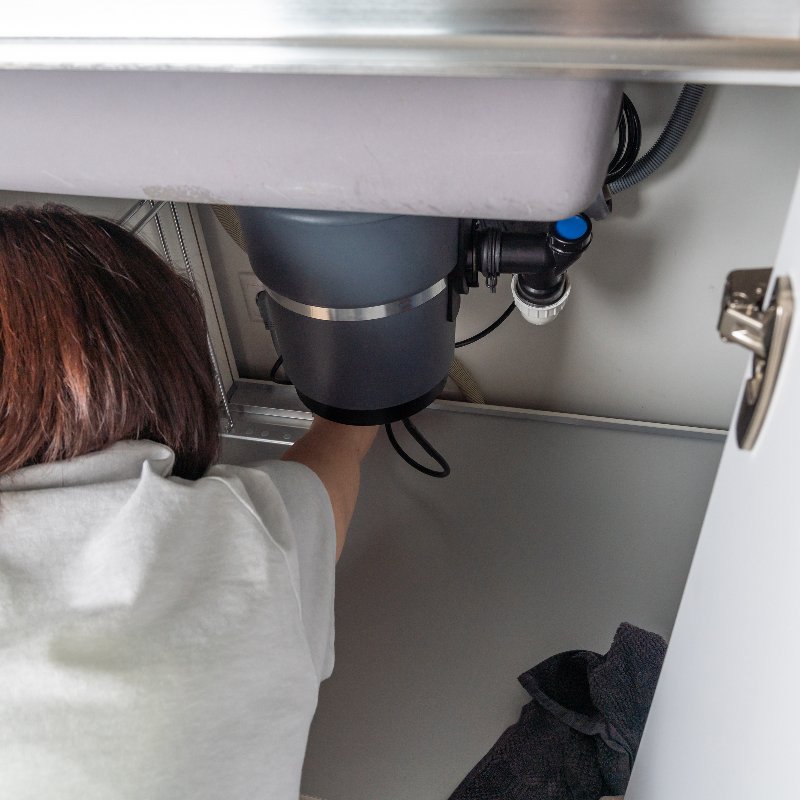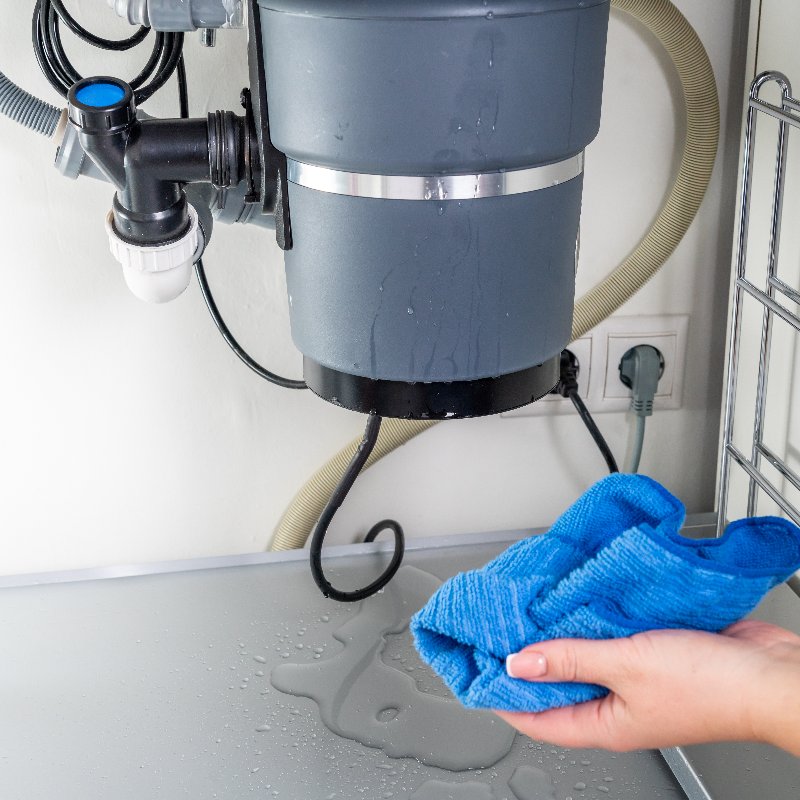
Dealing With a Broken Garbage Disposal
Is something smelling rotten in your kitchen? You’ve taken out the trash, all the dishes have been washed, and the dishwasher has completed its cycle, so what is that odor? Perhaps your garbage disposal lifespan has come to an end? Or maybe garbage disposal repair will save it for a few more years!
What does it mean if a garbage disposal smells like rotten eggs?
While garbage disposals are something that once was considered an amenity, most homes are equipped with them today. They can make cleaning up after a meal or a day of baking easier and faster. They can also be the culprit of that awful odor in your kitchen! But that doesn’t mean it is done for and needs to be replaced.
Chances are, your garbage disposal has had something put in it that didn’t grind up thoroughly and rinse away as intended. When food scraps don’t get broken up and ground up fully, that food is going to go bad and start to smell. There usually isn’t any major garbage disposal repair needed, just some after-care steps:
- Pour a bio-enzyme drain cleaner into the unit, run water and turn it on.
- Or go with a more all-natural mixture of baking soda and white vinegar, half a cup each, along with running hot water, and let the unit run for a few minutes.
- You can also place a few ice cubes or pieces of citrus fruits in the unit and let it run with hot water.
What does it mean when your garbage disposal just hums?
It doesn’t automatically mean you need new garbage disposal simply because it is buzzing or humming. These sounds are telling you that the unit is getting power, but the blades can’t turn. This may be a clogged motor or jammed blades that can’t grind. There may be food lodged in it or there could be some non-food item in there, not as unusual as you may think!
The following steps will walk you through doing your own garbage disposal repair:
- Unplug the garbage disposer to cut the electrical circuit off and keep you from being electrocuted.
- At the bottom of the unit under the sink, there should be an Allen wrench in the breaker socket.
- Turn the tool back and forth, this will usually free whatever is jammed in the blades.
- If your garbage disposer doesn’t have an Allen wrench and hex hole on the bottom, force a broomstick into the garbage disposer, against one of the blades to move back and forth.
- Plug the unit back in and try to use it. If this typical garbage disposal repair didn’t work, call your local plumber.
When you’re doing a lot of cooking, holidays are the usual time this happens, garbage disposals tend to get clogged. Knowing what to do when a garbage disposal is clogged will save you from being frustrated, calling a plumber, and save you money.
First, you should NEVER use a liquid drain cleaner in the garbage disposal! Drain liquid cleaners are dangerous and will erode the plastic and rubber components, including the splash guard which is your protection.
Before you attempt the following cleaning process, turn the unit off, and DO NOT stick your hand in the unit! Do not attempt these steps for an unclogging garbage disposal repair if the unit is warm.
1. Manual Inspection
With the power off, using a flashlight, look inside the disposal. You maybe see whatever it is that has clogged the unit. If you see anything, use a pair of pliers or tongs, and reach inside to pull out whatever it may be, which could be a dishcloth, plastic wrap, paper towel, etc.
2. Baking Soda and White Vinegar
An all-natural DIY remedy is a half-cup of baking soda and half-cup of white vinegar poured into the garbage disposal side of the sink. You’ll get a fizzy foam that is cutting through any food clogging the unit while it cleans it too. This will unclog things like fat, grease, and oil and makes a great deodorizer too.
- Pour the baking soda in first.
- Then pour the white vinegar in.
- Let the fizz work for twenty minutes.
- Then run hot water for 10-20 minutes to wash away the residue of the mixture and food waste.
3. Plunge It
Sometimes, you need an old-fashioned kitchen plunger for this garbage disposal repair! loosen and move.
- Covering the other drain with a stopper.
- Cover the garbage disposal drain with the plunger.
- Fill that side of the sink up with water, making sure you have a watertight seal with the plunger.
- Now, vigorously plunge up and down, repeating for several minutes.
- Use a flashlight and see if there is anything that needs to be removed with pliers or tongs.
- Now run cold water and try the unit again.
If none of these have worked, try the Allen hex wrench or broom handle process described above. And if that doesn’t work, you’ll need to call a professional plumber that knows how a garbage disposal works and offers garbage disposal repair services.
What if there is water under the sink beneath the garbage disposal? That could be where the nasty odor is coming from. Knowing what to do when a garbage disposal is leaking could save you from having to call a plumber and will minimize the amount of damage all that water under the sink can cause.
Leaking From the Top: It is probably at the very top rim where the rubber seal and flange mount.
- Unplug the disposal and disconnect it from the drain. If you have a dishwasher, you’ll need to disconnect the drain hose.
- Remove the garbage disposal by loosening the mounting nut.
- Install the new gasket, following the instructions that come with the gasket. Make sure it pops into the lip of the unit and is flat.
- Reinstall the unit and test it.
Leaking at the Flange: This is a common area for leaks, located in the upper area of the unit.
- Unplug the disposal and disconnect it from the drain. If you have a dishwasher, you’ll need to disconnect the drain hose.
- Remove the garbage disposal by loosening the mounting nut.
- Remove the flange by loosening the bolts that hold it in place.
- Using a screwdriver, pop the clip out and pull the top flange out.
- Using plumbers’ putty, reseal the flange by forming a snake-like gasket wrapped onto the flange rim.
- Replace the flange, reinstall the unit, and test.
Where does the garbage disposal go?
If you don’t have a garbage disposal, you may be thinking about installing one. You can do it yourself, they come with instructions and there are plenty of online videos that can guide you through the process too. Garbage disposals are mounted to the underside of a two-sided sink, you can choose either one, but if you have a dishwasher, or will be installing one, it should be mounted to the side closest to the dishwasher.
Will a garbage disposal clog pipes or will a garbage disposal harm a septic system?
With proper installation and use of garbage disposal, it should never clog your pipes. However, it is recommended to never have garbage disposal when on a septic system. It will take up space in the tank, making your septic system less effective for what it is meant to be used. And there are methods that are greener in disposing of food waste, like starting a compost pile.

In Conclusion
A garbage disposal can be an addition to the kitchen. With proper use and maintenance, you should never need any garbage disposal repairs and get up to 10-12 years of use from a quality brand.

